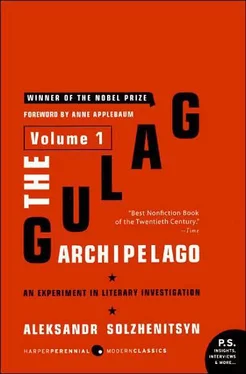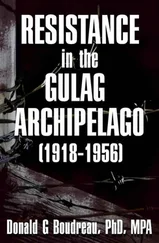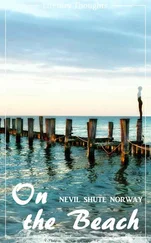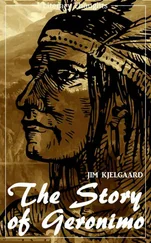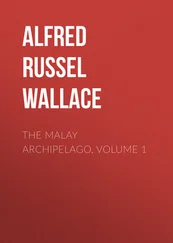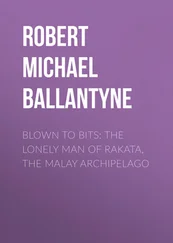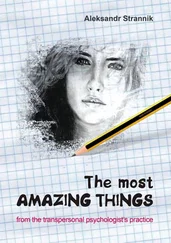In 1940 Olenyev’s prisoner transport, after disembarking from the barge, was herded on foot through the taiga (from Knyazh-Pogost to Chibyu) without anything to eat at all. They drank swamp water and very quickly got dysentery. Some fell by the wayside out of weakness, and the dogs tore the clothes off those who had fallen. In Izhma they caught fish by using their trousers as nets and ate them alive. (And in a certain meadow they were told: Right here is where you are going to build a railroad from Kotlas to Vorkuta.)
And in other areas of our European North, prisoner transports on foot were standard until the time when, on those same routes and roadbeds built by those earlier zeks, the jolly red cattle cars rolled along carrying later prisoners.
A particular technique for prisoner transports on foot was worked out where such transports were frequent and abundant. When a transport is being taken through the taiga from Knyazh-Pogost to Veslyana, and suddenly some prisoner falls by the wayside and can go no farther, what is to be done with him? Just be reasonable and think about it: what? You aren’t going to stop the whole transport. And you aren’t going to leave one soldier behind for everyone who falls. There are many prisoners and only a few soldiers. And what does that mean? The soldier stays behind for a little while with the fallen prisoner and then hurries on to catch up with the rest—alone.
Regular transports on foot from Karabas to Spassk were retained for a long time. It was only twenty to twenty-five miles, but it had to be covered in one day, with one thousand prisoners in each transport, many of them very weak. It was expected in cases like these that many would simply either drop in their tracks or else fall behind through the indifference and apathy of dying men—you may shoot at them but they still can’t go on. They are not afraid of death, but what about clubs, the indefatigable beating of the clubs wherever they hit? They are afraid of clubs, and they will keep going. This is a tested method—that’s how it works. And so in these cases the transport column is surrounded not only by the ordinary chain of machine gunners at a distance of fifty yards, but also by an inner chain of soldiers armed only with clubs. Those who have fallen behind get beaten. (As, in fact, Comrade Stalin prophesied.) They are beaten again and again. And even when they have no strength at all with which to go farther, they keep going. And many do miraculously get to the destination. They don’t know that this is a testing by clubs, and that those who lie down and stay lying down and don’t go on despite the clubs are picked up by carts following behind. That’s organizational experience for you! (And one can ask: Why, then, didn’t they take them all on carts in the first place? But where could enough carts be found? And horses? After all, we have tractors. What about the price of oats nowadays?) Such transports as these were still common in 1948-1950.
And in the twenties, transport on foot was one of the basic methods. I was a small boy, but I remember very well how they drove them down the streets of Rostov-on-the-Don without any qualms. And the famous order: “…will open fire without warning!” had a different ring at that time, again because of a difference in technology: after all, the convoy often had only sabers. They used to deliver orders like this: “One step out of line and the convoy guard will shoot and slash!” That had a very powerful sound: “shoot and slash!” You could imagine them cutting off your head from behind.
Yes, and even in February, 1936, they drove on foot through Nizhni Novgorod a transport of long-bearded old men from the other side of the Volga, in their homespun coats and in real lapty—bast sandals—wrapped around with onuchi—Russian peasant footcloths—“Old Russia disappearing.” And all of a sudden, right across their path, came three automobiles, in one of which rode the Chairman of the Central Executive Committee, President of the Soviet Union, this is to say, Kalinin. The prisoner transport halted. Kalinin went on through. He wasn’t interested.
Shut your eyes, reader. Do you hear the thundering of wheels? Those are the Stolypin cars rolling on and on. Those are the red cows rolling. Every minute of the day. And every day of the year. And you can hear the water gurgling—those are prisoners’ barges moving on and on. And the motors of the Black Marias roar. They are arresting someone all the time, cramming him in somewhere, moving him about. And what is that hum you hear? The overcrowded cells of the transit prisons. And that cry? The complaints of those who have been plundered, raped, beaten to within an inch of their lives.
We have reviewed and considered all the methods of delivering prisoners, and we have found that they are all… worse. We have examined the transit prisons, but we have not found any that were good. And even the last human hope that there is something better ahead, that it will be better in camp, is a false hope.
In camp it will be… worse.
Chapter 4
From Island to Island
And zeks are also moved from island to island of the Archipelago simply in solitary skiffs. This is called special convoy. It is the most unconstrained mode of transport. It can hardly be distinguished from free travel. Only a few prisoners are delivered in this way. I, in my own career as a prisoner, made three such journeys.
The special convoy is assigned on orders from high officials. It should not be confused with the special requisition, which is also signed by someone high up. A special-requisition prisoner usually travels on the general prisoner transports, though he, too, meets up with some amazing interludes on his trip (which are all the more extraordinary in consequence). For example, Ans Bern-shtein was traveling on a special requisition from the North to the lower Volga, to join an agricultural mission. He was exposed to all the overcrowded conditions and humiliations I have described, snarled at by dogs, surrounded by bayonets, threatened with “One step out of line…” And then suddenly he was unloaded at the small station at Zenzevatka and met by one single, calm, unarmed jailer. The jailer yawned: “All right, you’ll spend the night at my house, and you can go out on the town as you like till morning. Tomorrow I’ll take you to the camp.” And Ans did go out. Can you understand what going out on the town means to a person whose term is ten years, who has already said good-bye to life countless times, who was in a Stolypin car that very morning and will be in camp the next day? And he immediately went out to watch the chickens scratching around in the station master’s garden and the peasant women getting ready to leave the station with their unsold butter and melons. He moved three, four, five steps to the side and no one shouted “Halt!” at him. With unbelieving fingers he touched the leaves of the acacias and almost wept.
And the special convoy is precisely that sort of miracle from beginning to end. You won’t see the common prisoner transports this time. You don’t have to keep your hands behind your back. You don’t have to undress down to your skin, nor sit on the earth on your rear end, and there won’t be any search at all. Your convoy guards approach you in a friendly way and even address you politely. They warn you, as a general precaution, that in case of any attempt to escape—We do, as usual, shoot. Our pistols are loaded and we have them in our pockets. However, let’s go simply. Act natural. Don’t let everyone see that you’re a prisoner. (And I urge you to note how here, too, as always, the interests of the individual and the interests of the state coincide completely.)
My camp life was totally transformed the day I went out to line up forlornly in the carpenters’ brigade, my fingers cramped (they had gotten stiff holding onto tools and wouldn’t straighten out), and the work-assignment supervisor took me aside and with unexpected respect said to me: “Do you know that on orders of the Minister of Internal Affairs… ?”
Читать дальше
